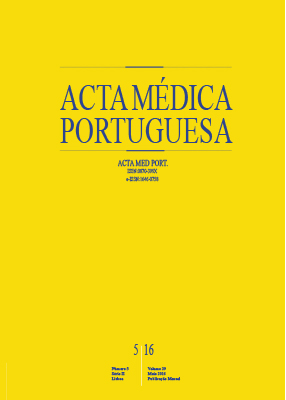Surgical Treated Spondylodiscitis Epidemiological Study
DOI:
https://doi.org/10.20344/amp.6549Keywords:
Discitis/surgery, Discitis/epidemiology, Orthopedic Procedures.Abstract
Introduction: The term spondylodiscitis aims to describe any spinal infection. Medical treatment is the gold standard; nevertheless, surgical treatment can be indicated. The aim of this work was to study the epidemiological profile in a group of patients with spondylodiscitis surgically treated in the same medical institution between 1997 and 2013.
Material and Methods: Eighty five patients with spondylodiscitis were surgically treated in this period. The authors analysed clinical data and image studies for each patient.
Results: We treated 51 male and 34 female patients with an average age of 48 years old (min: 6 - max: 80). The lumbar spine was more often affected and Mycobacterium tuberculosis the most frequent pathogen. The number of cases through the years has been grossly stable, with a slight increase of dyscitis due to Staphylococcus aureus and decrease of the dyscitis without pathogen identification. Paravertebral abscess was identified in 39 patients and 17 had also neurological impairment, mostly located in the thoracic spine and with tuberculous aetheology. Immunosuppression was documented in 10 patients.
Discussion: In this epidemiologic study we found a tuberculous infection, male gender and young age predominance. Despite a relative constant number of patients operated over the years, pyogenic infections due to Staphylococcus aureus seems to be uprising. Paravertebral abscess and neurological impairment are important dyscitis complications, especially in tuberculous cases.
Conclusion: Spinal infections requiring surgical treatment are still an important clinical condition. Mycobacterium tuberculosis and Staphylococcus aureus represent the main pathogens with a growing incidence for the latest.
Downloads
Downloads
Published
How to Cite
Issue
Section
License
All the articles published in the AMP are open access and comply with the requirements of funding agencies or academic institutions. The AMP is governed by the terms of the Creative Commons ‘Attribution – Non-Commercial Use - (CC-BY-NC)’ license, regarding the use by third parties.
It is the author’s responsibility to obtain approval for the reproduction of figures, tables, etc. from other publications.
Upon acceptance of an article for publication, the authors will be asked to complete the ICMJE “Copyright Liability and Copyright Sharing Statement “(http://www.actamedicaportuguesa.com/info/AMP-NormasPublicacao.pdf) and the “Declaration of Potential Conflicts of Interest” (http:// www.icmje.org/conflicts-of-interest). An e-mail will be sent to the corresponding author to acknowledge receipt of the manuscript.
After publication, the authors are authorised to make their articles available in repositories of their institutions of origin, as long as they always mention where they were published and according to the Creative Commons license.









